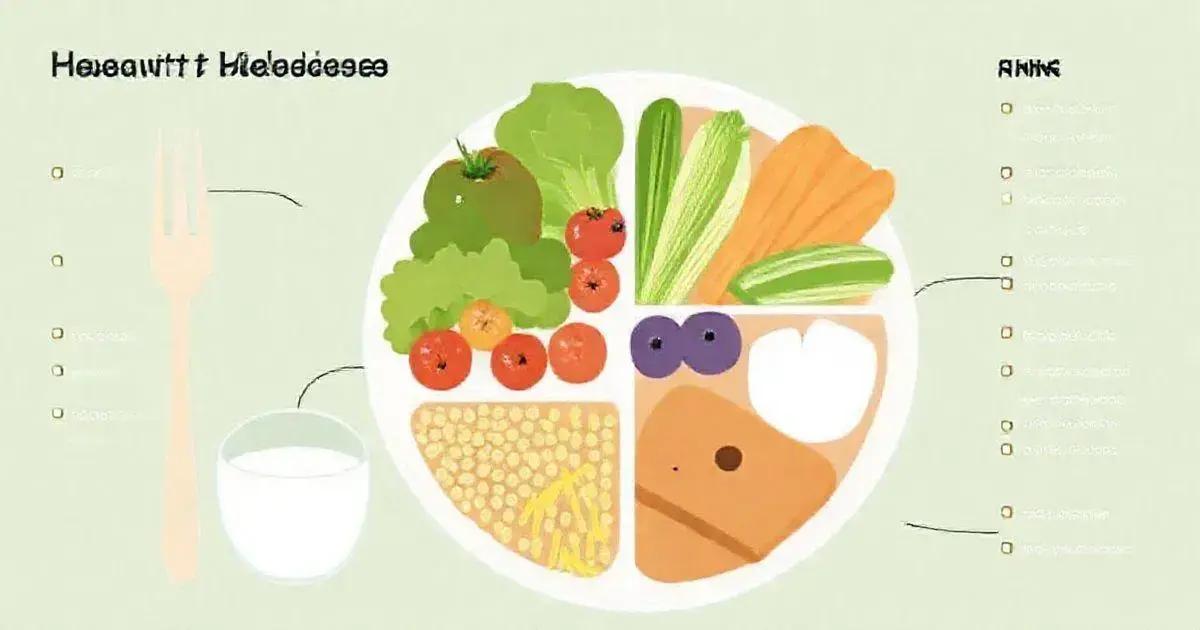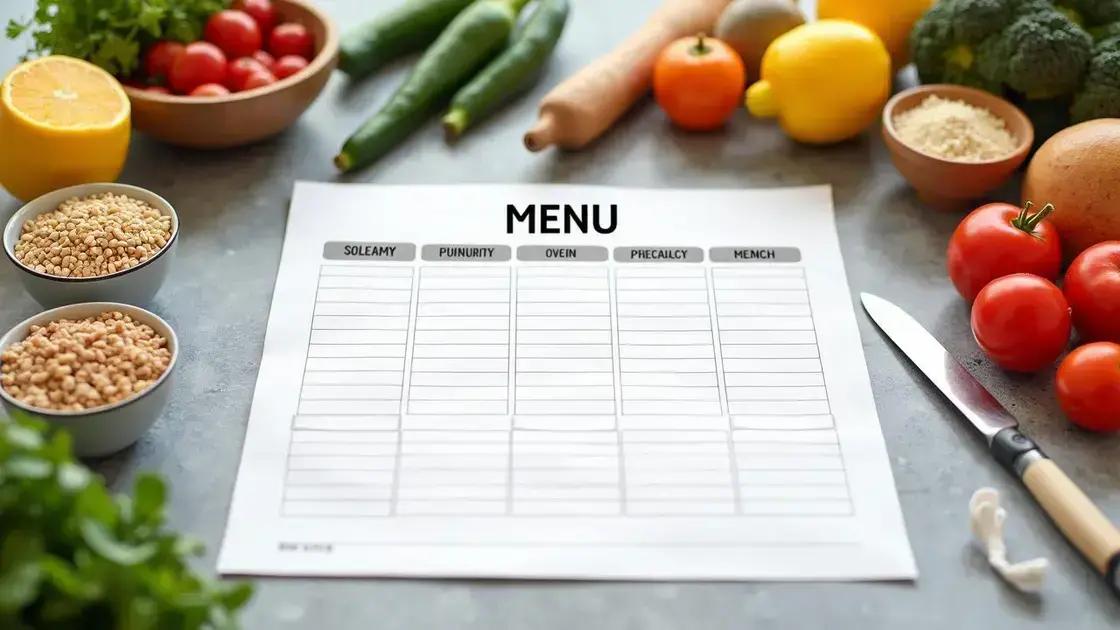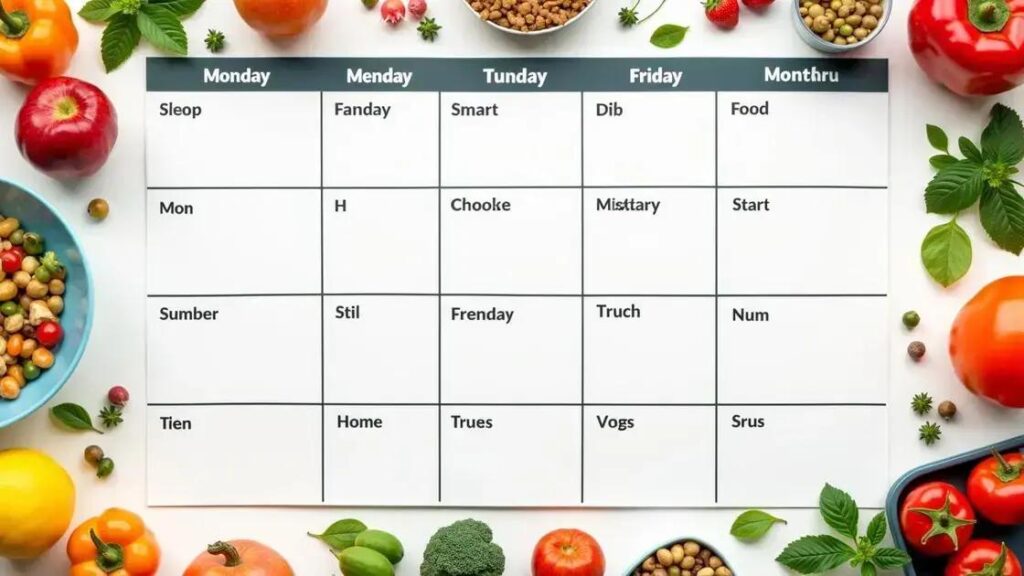Planning a weekly menu for balanced eating effectively involves understanding food groups, setting realistic goals, gathering healthy recipes, and using strategies like meal prep and flexibility to stick to your menu. This method not only promotes nutritious eating but also simplifies meal preparation and enhances overall well-being.
Planning a weekly menu for balanced eating is vital for maintaining a nutritious diet. By dedicating time to prepare your meals, you can ensure you meet your dietary needs while enjoying a variety of foods. This article will guide you through understanding balanced eating, steps to create your menu, delicious recipe ideas, and practical tips to stay on track.
Understanding Balanced Eating

Understanding balanced eating is essential for maintaining good health and well-being. It focuses on getting the right mix of nutrients from various food groups. Each food group plays a unique role in our diet, which is vital for our bodies to function correctly.
The Major Food Groups
There are five major food groups: fruits, vegetables, grains, proteins, and dairy. Each group provides different vitamins, minerals, and other essential nutrients.
Proportions Matter
A balanced plate should consist of 50% fruits and vegetables, 25% protein, and 25% whole grains. This balance helps to provide energy, repair tissues, and support various bodily functions.
Benefits of Balanced Eating
Balanced eating can help you maintain a healthy weight, reduce the risk of chronic diseases, and improve overall wellness. Eating a variety of foods also keeps meals interesting and satisfying.
Mindful Eating
Practice mindful eating by paying attention to hunger cues and enjoying your meals without distractions. This habit can help you make better food choices and appreciate the flavors and textures of your food.
Steps to Plan Your Weekly Menu

Planning your weekly menu can help maintain balanced eating. Here are the essential steps to create an effective menu.
1. Gather Your Recipes
Start by collecting favorite recipes that fit a balanced diet. Include a mix of fruits, vegetables, grains, and proteins. Aim for diversity to keep meals interesting.
2. Check Your Schedule
Look at your weekly schedule to see when you will have time to cook. If you have busy days, plan for quick meals or leftovers. Don’t forget to leave room for snacks!
3. Create a Menu Template
Design a simple template that includes each day of the week. Include sections for breakfast, lunch, dinner, and snacks. This visual guide helps you see what to prepare each day.
4. Make a Shopping List
Based on your menu, create a shopping list. Ensure you have all the ingredients needed for your recipes. Try to buy fresh produce and whole foods for healthier meals.
5. Prepare in Advance
If possible, spend a little time each week preparing meals. This might include chopping vegetables or cooking grains. This step can save time during busy days.
Healthy Recipe Suggestions

Here are some healthy recipe suggestions that align perfectly with balanced eating. These recipes are easy to prepare and delicious!
1. Quinoa Salad
This colorful salad includes cooked quinoa, chopped cucumbers, cherry tomatoes, red onions, and parsley. Toss with olive oil, lemon juice, salt, and pepper for a refreshing meal.
2. Grilled Chicken with Vegetables
Marinate chicken breasts in olive oil, garlic, and herbs. Grill alongside a mix of bell peppers, zucchini, and asparagus. Serve with brown rice for a complete dish.
3. Vegetable Stir-Fry
Sauté a mix of your favorite vegetables such as broccoli, carrots, and snap peas in a splash of soy sauce or sesame oil. Serve over whole grain rice or noodles.
4. Overnight Oats
Combine rolled oats with almond milk, chia seeds, and your choice of sweetener. Add fruits like bananas or berries. Let it sit overnight for a quick, nutritious breakfast.
5. Baked Salmon
Place salmon fillets on a baking sheet. Season with lemon, dill, and a drizzle of olive oil. Bake until cooked through. Serve with steamed greens for a healthy meal.
Tips for Sticking to Your Menu

Sticking to your menu can be challenging, but these tips for sticking to your menu will help you stay on track:
1. Set Realistic Goals
Begin with achievable goals. If you’re new to meal planning, start with just a few days a week instead of the whole week. Gradually increase as you become accustomed.
2. Keep Your Menu Visible
Print your menu and place it on your fridge or kitchen counter. This reminder can help you stay focused and prevent last-minute changes that lead to unhealthy choices.
3. Prep Meals Ahead
Spend some time each week preparing meals. Cook extra portions to have leftovers. This saves time during busy days and helps you avoid processed foods.
4. Stay Flexible
Life can be unpredictable! Be prepared to adjust your menu if needed. Swap meals or ingredients instead of skipping them entirely. This will help you stay committed without feeling stressed.
5. Involve Others
If you share meals with family or friends, involve them in the planning process. This teamwork can make meal times more enjoyable and ensure everyone’s preferences are considered.
Wrapping Up Your Journey to Balanced Eating
Planning a weekly menu for balanced eating is a powerful way to take control of your nutrition and improve your overall health. By understanding the principles of balanced eating, setting realistic goals, and utilizing the tips provided, you can create a meal plan that works for you.
Remember to gather healthy recipes, stay flexible, and involve others in the process for added support. Sticking to your menu becomes easier with practice and preparation.
Embrace the journey towards healthier eating habits, and enjoy the diverse and delicious meals that come with it. Your body will thank you!
FAQ – Frequently Asked Questions About Planning a Weekly Menu for Balanced Eating
What is balanced eating?
Balanced eating involves consuming a mix of food groups to provide essential nutrients, promoting good health and well-being.
How do I start planning my weekly menu?
Begin by gathering your favorite healthy recipes, checking your schedule, and creating a menu template to organize your meals.
What should my weekly menu include?
Your menu should include a variety of fruits, vegetables, whole grains, proteins, and dairy to ensure a balanced diet.
How can I stick to my weekly menu?
Set realistic goals, keep your menu visible, prep meals in advance, stay flexible, and involve others to maintain motivation.
What are some healthy recipe ideas?
Try quinoa salad, grilled chicken with vegetables, vegetable stir-fry, overnight oats, and baked salmon for healthy meal options.
How can meal prep benefit my eating habits?
Meal prep saves time during busy days, helps avoid unhealthy food choices, and allows you to enjoy home-cooked meals with ease.












